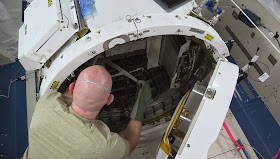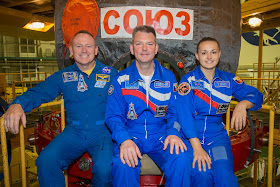mercredi 17 septembre 2014
Station Crew Trains to Capture Dragon
ISS - Expedition 41 Mission patch.
September 17, 2014
While they await next week’s launch of the other half of their crew to the International Space Station, Expedition 41 Commander Max Suraev and Flight Engineers Reid Wiseman and Alexander Gerst focused Wednesday on health checks, cargo operations and robotic practice for the capture of the SpaceX Dragon resupply ship set to launch Saturday.
Commander Suraev began the day downloading micro-accelerometer data from the Identification experiment. This study measures the loads on the station during dynamic events like reboosts, such as the one that took place on Saturday when the engines of the “Georges Lemaitre” Automated Transfer Vehicle-5 docked to the Zvezda service module were fired to adjust the station’s orbit.
Afterward, Suraev conducted a communications system test before moving on to replace hardware inside Zvezda.
Meanwhile, Wiseman was assisting Gerst with more eye exams for the ongoing Ocular Health study. After Gerst performed a vision test, Wiseman used a tonometer to check the pressure of his German crewmate’s eyes and assisted with a blood pressure reading. NASA recently identified that some astronauts experience changes in their vision, which might be related to effects of microgravity on the cardiovascular system as the body’s fluids tend to move toward the upper body and head and cause the pressure in the skull to rise. Flight surgeons are keeping close tabs on this issue to maintain the crew’s ocular health and develop countermeasures to reduce the risk.
Image above: In the International Space Station's Harmony node, Flight Engineer Alexander Gerst performs an eye exam for the Ocular Health experiment which observes and seeks to understand vision changes during long-term space missions. Image Credit: NASA.
Wiseman then gathered hardware and set up the Maintenance Work Area for some replacement work he will perform Thursday on the Combustion Integrated Rack’s Multi-user Droplet Combustion Apparatus. The rack, which includes an optics bench, combustion chamber, fuel and oxidizer control and five different cameras, allows a variety of combustion experiments to be performed safely aboard the station.
Wiseman took a brief break in the morning to use the amateur radio in the Columbus laboratory to talk with students in Switzerland about living and working in space.
As they moved into the heart of the workday, Gerst and Wiseman focused on preparations for the arrival of the fourth SpaceX commercial resupply services mission, SpaceX CRS-4. The SpaceX Dragon cargo ship, loaded with more than 5,000 pounds of scientific experiments and supplies, will launch from the Cape Canaveral Air Force Station in Florida on Saturday at 2:16 a.m. NASA Television coverage of the launch will begin at 1:15 a.m.
Image above: Though clouds over Florida in this Expedition 41 picture from the International Space Station cover most of the state, their adherence to the outline of the peninsula give away the identity of the state. Image Credit: NASA.
Gerst and Wiseman will use the 57-foot Canadarm2 robotic arm to capture the commercial cargo craft around 7:30 a.m. Monday for its berthing to the Earth-facing port of the Harmony node. NASA TV coverage of the grapple will begin at 5:30 a.m. Coverage will resume at 9:30 a.m. for the installation of Dragon to Harmony.
Learn more about SpaceX CRS-4: http://www.nasa.gov/spacex
To prepare for the influx of new science and supplies, Gerst and Wiseman participated in a conference with the ground team to discuss the Dragon cargo operations. Later, Gerst and Wiseman conducted some on-board training to practice the procedures for grappling Dragon with Canadarm2.
Wiseman then packed up the Fundamental and Applied Studies of Emulsion Stability experiment, or FASES, for return to Earth aboard Dragon. The SpaceX cargo ship will remain attached to Harmony for more than four weeks and then splash down in the Pacific Ocean with almost two tons of experiment samples and equipment returning from the station.
Image above: Flight Engineer Alexander Gerst uses a strip of tape to help secure the doors of the NanoRacks CubeSat deployer mechanism inside the Kibo airlock aboard the International Space Station. Image Credit: NASA.
Wiseman also powered up the Commercial Generic Bioprocessing Apparatus, which provides a temperature-controlled environment for experiments on cells, microbes and plants.
Gerst, who spent some time in the Columbus laboratory for a pair of in-flight interviews, spent much of the remainder of his day working in the Kibo laboratory. After he pressurized the Japanese lab’s scientific airlock, he opened the door to access the NanoRacks CubeSat deployer mechanism inside the airlock. The deployer mechanism was used to deploy CubeSats into orbit while it was attached to the end of the Japanese robotic arm outside the station last month. While some of the mechanism’s CubeSats were deployed successfully last month, others did not eject from the mechanism as planned. With the deployer mechanism now back inside the airlock, Gerst secured the doors to the two remaining CubeSats to prevent any further inadvertent deploys.
Image above: At the Baikonur Cosmodrome in Kazakhstan, NASA astronaut Barry Wilmore, Soyuz Commander Alexander Samokutyaev and Flight Engineer Elena Serova pose for pictures Sept. 13 in front of their Soyuz TMA-14 spacecraft. Image Credit: NASA/Victor Zelentsov.
Suraev spent his afternoon stowing trash and unneeded items inside the ISS Progress 56 cargo craft docked to the Pirs docking compartment. That resupply ship, which delivered nearly three tons of cargo when it arrived on July 23, will undock from the station in late October for a destructive re-entry over the Pacific Ocean.
Suraev, Wiseman and Gerst closed out the day with a handover conference to pass along the lessons learned during their first four months aboard the station to the next three crew members set to arrive next week. NASA astronaut Barry Wilmore, Soyuz Commander Alexander Samokutyaev and Flight Engineer Elena Serova are at the Baikonur Cosmodrome in Kazakhstan completing final preparations for their launch aboard the Soyuz TMA-14M spacecraft on Sept. 25 at 4:25 p.m. (Sept. 26. at 2:25 a.m., Kazakh time). After a six-hour, four-orbit trek to the orbiting complex, Wilmore, Samokutyaev and Serova will spend nearly six months living and working in space.
Learn more about Expedition 41: http://www.nasa.gov/mission_pages/station/expeditions/expedition41/
Related links:
Ocular Health study: http://www.nasa.gov/mission_pages/station/research/experiments/204.html
Fundamental and Applied Studies of Emulsion Stability experiment, or FASES: http://www.nasa.gov/mission_pages/station/research/experiments/602.html
For more information about the International Space Station (ISS), visit: http://www.nasa.gov/mission_pages/station/main/index.html
Images (mentioned), Text, Credits: NASA.
Cheers, Orbiter.ch





